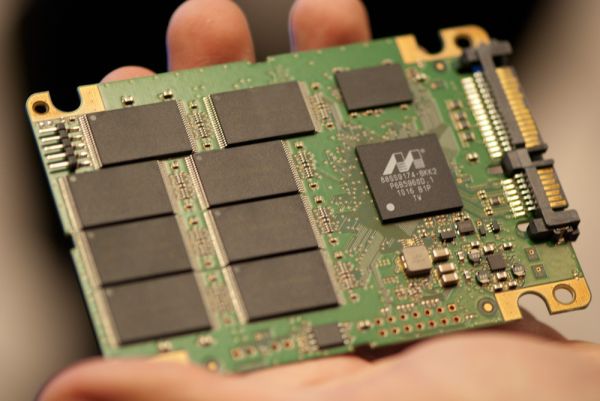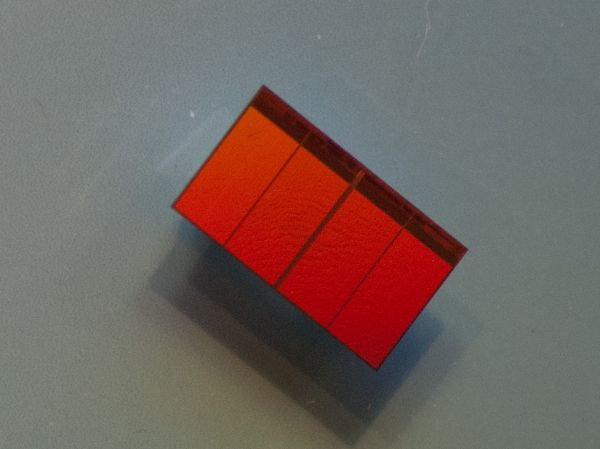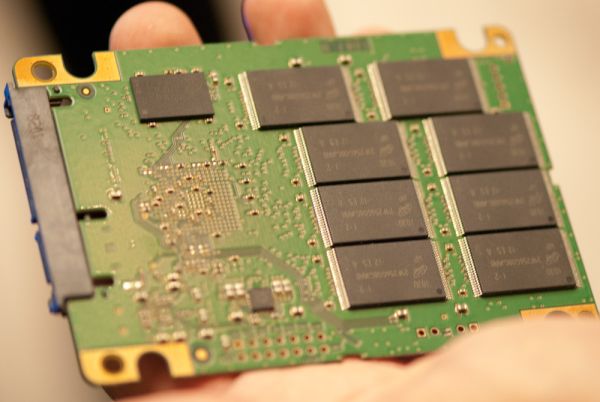Micron's RealSSD C400 uses 25nm NAND at $1.61/GB, Offers 415MB/s Reads
by Anand Lal Shimpi on January 4, 2011 8:20 PM EST- Posted in
- Storage
- SSDs
- Micron
- CES 2011
- RealSSD C400
Here’s a little deja vu for you. At last year’s Storage Visions (a small storage show that precedes CES) Micron announced its first 6Gbps SSD, the RealSSD C300. Although met with its fair share of growing pains in the form of firmware issues, the C300 ended up being a competent performer throughout most of 2010.
This year, once again at Storage Visions, Micron announced its next generation SSD: the RealSSD C400. Based on the same architecture as the C300, the C400 is a combination of IMFT 25nm NAND, a slightly tweaked controller and a significant improvement in firmware.
The controller is still a Marvell 6Gbps solution, while the firmware is all Micron’s own development. As Micron (and SandForce) have proved in the past, it’s not so much the raw processing power of the controller but the architecture of the firmware that really matters.
The controller is still paired with a 256MB DRAM to cache LBA to NAND page mapping and act as a scratch area for the Marvell controller. Unlike the C300 however, the 64GB version of the C400 will only have a 128MB cache (the 64GB C300 had a 256MB cache).
Despite using IMFT’s 25nm NAND (at roughly 3,000 program/erase cycles per NAND cell), Micron claims the C400 will last for at least 72TB of writes over its lifetime which is identical to how long Micron claims the C300 will last. I asked Micron why the C400 didn’t incur any endurance penalty with the switch to 25nm, its answer was simple: the C300 was conservatively rated. Even though the C300 NAND cells will last longer, both it and the C400 will at least make it to Micron’s 72TB rating. Micron also mentioned to me that it writes more than 72TB of data to its drives during development, so this is a verified rating.
The move to 25nm NAND gives us one major improvement: cost. The 512GB C400 will be priced at $825 in 1,000 unit quantities - that works out to be $1.611 per GB. The 256GB drive will go for $425, the 128GB at $210 and the 64GB somewhere above $100. As 25nm production ramps up I wouldn’t be too surprised to see SSD prices drop down to the magical $1/GB price point.
Price isn’t the only benefit of the C400, performance should be much improved as well. Micron is claiming sequential read speeds of 415MB/s and sequential write speeds of up to 260MB/s (256/512GB drives). The 128GB drive is good for up to 175MB/s sequential writes. Random write performance is unknown at this point but I heard Micron mention something around 50,000 4KB random write IOPS.
The raw specs are much better than what we have today however not quite as high as what SandForce is promising with its SF-2000. The difference is availability, while we saw the C400 in action and it’ll be shipping in February, SF-2000 drives are more than a quarter away.
Crucial, Micron’s retail arm, will be selling the C400 under its brand as the Crucial M4.













39 Comments
View All Comments
Reikon - Wednesday, January 5, 2011 - link
A principle thing? You do realize the reason smaller drives tend to be slower is because there are fewer NAND chips, which results in fewer channels to write to, right? It's not being throttled.7Enigma - Wednesday, January 5, 2011 - link
I was just about to post the same thing....for once it's not a marketing decision, it's a design consequence.AnotherGuy - Wednesday, January 5, 2011 - link
well ur right but also... it says they put only 128mb ram on the 64gb drive instead of 256mb like the rest of the line... not sure how much impact that has... anyone?tipoo - Wednesday, January 5, 2011 - link
Thats not their fault though. Just like 2TB standard hard drives have better performance characteristics than an equivalent smaller drive, its just physics. It happens for different reasons in HDD's than SSD's, but the point is the same.fic2 - Wednesday, January 5, 2011 - link
Wasn't Seagate or someone talking about hybrid drives. It would be nice to have about 64G flash for OS/applications and a 320G platter for data. The best of both worlds. This summer I bought a 7200rpm 320G laptop drive for $50. Kind of hard to justify spending 4x more for less storage even though it is faster.NCM - Wednesday, January 5, 2011 - link
There's a factory installed 128GB SSD boot drive in our new server, and I've installed the same size in one of our workstations for evaluation. Since all work files are on the server drive the workstation only needs enough capacity for the OS and applications, plus a bit of casual storage for personal files.Now I'd like to put an SSD in my laptop to replace the dog-slow 5400 rpm original drive, but the present capacity increments don't work well. For a main computer the (relatively) affordable 256GB isn't enough, but 512GB is a big jump way off into second mortgage price territory. Without a second bay — yeah I know, there are ways — for a conventional data drive to supplement the SSD boot drive it's hard to have this make any kind of sense.
Remember when 320GB was sort of a capacity vs. price sweet spot for laptop drives?
anandskent - Tuesday, January 4, 2011 - link
...waiting for the SF-2000 to come out and playRGrizzzz - Tuesday, January 4, 2011 - link
Are those prices for the 2.5", 1.8" or same for both?iwodo - Tuesday, January 4, 2011 - link
As i said in all previous SSD Article. Raw Speed, and Random I/O is only part of the performance equation. There are still unknown inside. Toshiba SSD manage to perform so well is something we can yet explain.Although looking at pure numbers, they are not very attractive. Interesting is how IMFT is making 25nm NAND for everyone else and yet Intel's own G3 SSD is not anywhere to be found.
Then there is the scary problem of NAND dropping RW cycle with every node. It is getting ridiculously small number.
semo - Wednesday, January 5, 2011 - link
At least im makes sense for crucial/micron to use 25nm IMFT flash but how did ocz end up using it in their 25nm edition vertex 2s before anyone else. I would have expected Anand to report on 25nm drives that are out already even though they are not faster or cheaper.